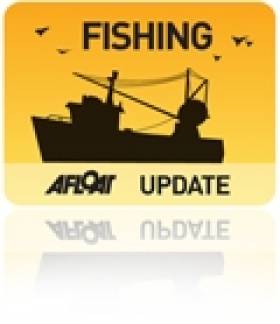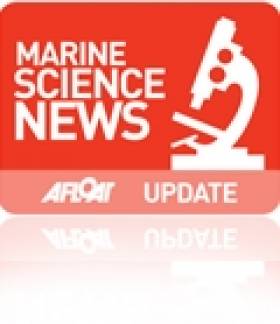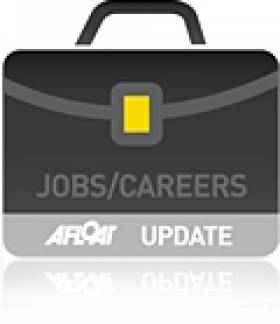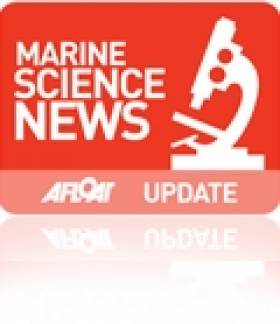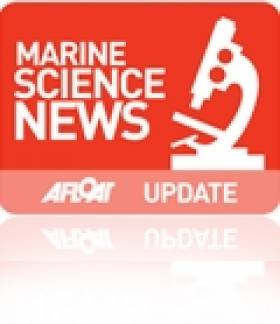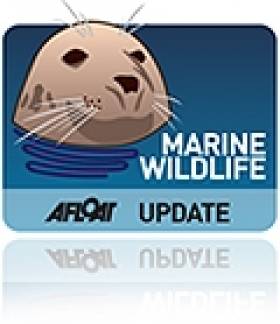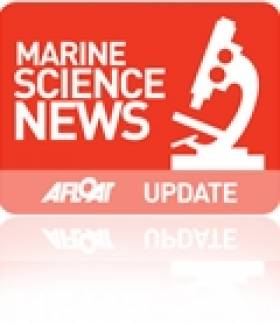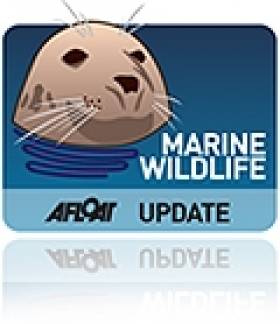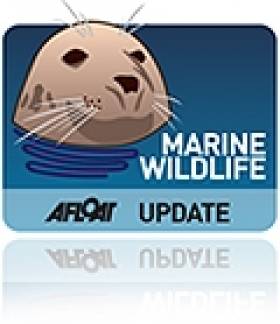Displaying items by tag: marine science
Marine Institute Hosts Aran Grounds Nephrops Fishery Meeting
#Fishing - The Marine Institute and Bord Iascaigh Mhara (BIM) convened an information meeting on the Aran Grounds Nephrops fishery and recent gear trials at the institute's headquarters in Oranmore this week.
The meeting on Tuesday 24 February was attended by more than 30 active skippers together with representatives from the IFPO, IS&WPO, IS&EPO and the KFO.
Marine Institute port-based and BIM gear technology personnel, as well as a Department of Agriculture, Food and Marine official were also in attendance.
Dr Paul Connolly, director of fisheries and ecosystem services at the Marine Institute, opened the meeting by saying that Nephrops (better known as Dublin Bay prawns or langoustines) are "a key resource for Irish fishermen, as over the last five years the value of the landings at first sale has doubled to almost €50m in 2014. Sustaining the stocks and the quota is a key management priority for the industry and the department."
He also noted that it was positive to see scientists and so many active fishermen discussing issues together.
The group heard presentations on the methodology and results of Marine Institute Nephrops Underwater Television Surveys (UWTV) on the Aran Grounds and other areas by Jennifer Doyle of the Marine Institute.
The latest ICES assessments and management advice for Nephrops on the Aran Grounds was also presented by Dr Colm Lordan from the Marine Institute, who chaired the discussions by the group.
Dr Lordan highlighted that "the assessments indicate that the stock size has declined to the lowest in the time series in 2014.
"Although fishing effort in terms of number of boat and days fished on the Aran Grounds shows no long-term trend since 1995, there has been an increase in both fishing power and efficiency with the increased uptake of quad rigs in the fishery".
According to Dr Lordan, a combination of high landings and reduced recruitment has resulted in harvest rates in 2012-2013 being twice that recommended by ICES.
He further advocated "national measures to reduce catches and effort in the short term in advance of the 2015 UWTV survey were required. This would demonstrate responsible management and give the best chance for increased stock size in June."
In response to this, Francis O'Donnell of the IFPO proposed that effort on vessels less than 20m would be limited to less than 20 days and effort for vessels larger than 20m would be limited to less than 10 days for the months of April and May. This was going to severely have an impact on some of his members, he said.
David Kirwan of the IS&EPO suggested that effort for all vessels be limited to less than 40 days for the three-month period April to June.
These proposals will be investigated by the Marine Institute to assess if they would be likely to deliver significant catch and effort reductions.
Scientists Discuss 'Unknown Treasure' Of The Atlantic Ocean
#MarineScience - The Atlantic Ocean: Our Unknown Treasure was on the agenda at the annual meeting of the American Association for the Advancement of Science (AAAS) in San Jose, California on Saturday 14 February.
Marine Institute chief executive Dr Peter Heffernan joined European Commission officials and leading scientists from the USA, Europe and Canada to discuss how to explore the largely unknown Atlantic Ocean; how new technologies can help us to challenge our understanding of the planet; and how new observation and visualisation tools can improve what we know about the seabed and inform science to help shape future marine policy.
The event built on the Galway Statement on Atlantic Ocean Research Co-operation signed at the Marine Institute in May 2013 by representatives from the EU, Canada and the US, launching an Atlantic Ocean Research Alliance.
Its goals are to better understand the Atlantic and the Arctic, to study the interplay between them, particularly relating to climate change, and to promote sustainable management of their resources.
Speaking about the event, Dr Heffernan said: "It's an exciting time, as all sides - European, US and Canadian - have shown engagement, planning and commitment to driving the Atlantic Ocean Research Alliance forward and preparing joint actions.
"There are very real global challenges to be tackled, and there is strong momentum now to create significant benefits such as better ecosystem assessments and forecasts and deeper understandings of vulnerabilities and risks.
"These transatlantic collaborations will also help to generate new tools to increase resilience and adaptation and to conserve our rich biodiversity. We also really need to foster public understanding of how ocean science and observation will address pressing issues for citizens and for the environment."
Dr Heffernan concluded: "The AAAS meeting gave an opportunity to see some of the collaborations that are undertaken in the Atlantic Ocean and discuss challenges for future research, technological developments, mapping and imaging as well as research co-operation across the Atlantic."
New Project Uses Seabed Mapping To Study Behaviour Of Fish
#MarineScience - Ciaran O’Donnell, a specialist in fisheries acoustic research with Fisheries Ecosystem Advisory services at the Marine Institute, has just begun a PhD research project that will link fisheries and seabed mapping acoustic technologies.
By using both technologies, he aims to learn more about how fish behave during acoustic surveys and therefore increase the precision of fish stock assessments.
O’Donnell’s research will focus on pelagic species – fish that swim in the water column – to see if there is avoidance behaviour during acoustic surveys and also to look at schooling behaviour and preferred habitat.
He’ll use the state-of-the-art multibeam echosounder system that has just been installed on the RV Celtic Explorer to look beyond the data normally captured during acoustic fisheries surveys to see if some or any of the fish being targeted by the survey are moving away from the research vessel as it passes overhead them.
“I’m really looking forward to the sea trials of the new multibeam next week (16-24 February) when we’ll get a chance to use the most advanced seabed mapping technology alongside acoustic fisheries technology. We should be able to see a much broader picture than before," said O'Donnell, a chief scientist on annual surveys for blue whiting, Celtic Sea herring and boarfish.
“Acoustic surveys are very targeted and focussed and this will allow us to capture new information about what the fish are doing beyond the target of the downward-looking fisheries echosounder. It will be like getting enhanced peripheral vision of the sea around the ship.
“We’ll be able to see if fish are moving away from the research vessel and out of the survey path and therefore will potentially enhance the precision of our current survey methods.”
The project will bring together technology and data from fisheries and seabed mapping and O’Donnell will work closely with the INFOMAR team and the advanced mapping services at the Marine Institute.
The research project, originally designed by the INFOMAR team, brings together a number of experienced researchers including Dr Chris McGonigle and Dr Rory Quinn of the University of Ulster, Dr Fabio Sacchetti of INFOMAR and the Marine Institute, and Dr David Reid of the Marine Institute and UCC.
Inland Fisheries Ireland Seeks Senior Scientist
#Jobs - Inland Fisheries Ireland (IFI) is recruiting a senior scientist with a specific focus on statistics and modelling, technical editorial support, GIS and data management.
This permanent leadership role will be part of a dynamic research team conducting research (both national and international) on Ireland’s fish species and will report to the head of research and development.
Applicants will be short listed for interview on the basis of information supplied in their CVs.
For the full job description, see the IFI website HERE. For any further details contact the HR Department, Inland Fisheries Ireland, 3044 Lake Drive, Citywest Business Campus, Dublin 24 at 01 8842 662 or [email protected].
The closing date for receipt of applications is 5pm on Friday 27 February 2015. Canvassing will disqualify. IFI is an equal opportunities employer.
Major Upgrade To Scientific Equipment On RV Celtic Explorer
#MarineScience - The marine research vessel Celtic Explorer is back in the water with a new suite of hydrographic and geophysical sonar systems.
According to the Marine Institute, the new instruments were installed during an extensive refit in the A&P yard in Falmouth, which began on 29 December under the supervision of P&O Maritime (Ireland) Ltd.
The main work carried out during the refit was the installation of state-of-the-art sonar systems for bathymetric mapping in deep and shallow waters, and the installation of a deepwater sub-bottom profiler.
Adjustments were also made to the hull to fit the Kongsberg EM302 multibeam system and an IXSEA Echoes sub-bottom profiler.
These systems will enhance the seabed mapping capabilities of the Celtic Explorer, with the EM302 echo sounder designed to perform mapping with high resolution and accuracy to depths of 6km. The sub-bottom profiler can operate at the same depths to examine and profile surface bedrock layers and sediments.
The vessel's drop keel has been fitted with an EM2040 multibeam system – the same as that fitted to sister vessel the Celtic Voyager last year – to carry out high resolution seabed mapping in shallower waters. The vessel's positioning and motion reference systems were also upgraded to the highest standard to allow the vessel to operate the new equipment to the required accuracy.
The two-and-a-half-yearly refit included major mechanical work such as the removal of the rudder for inspection and repair and overhaul of the stern thruster. The entire vessel was painted; cabins, laboratories and common areas were refitted; and minor repairs carried out as well as an overhaul of essential systems.
The Celtic Explorer will complete a survey in the North Sea and Baltic Sea before beginning sea trials of the new equipment in Irish waters in February. The capability of the new equipment will be tested in the deep waters off Ireland's West coast under the supervision of scientists from the Marine Institute's Advanced Mapping Services (AMS) team.
Once the new systems have been calibrated and tested, they will be used extensively this year, including on fisheries acoustic surveys where their water column capability will be used to study the aggregation morphology and vessel avoidance behaviour of pelagic fish species, as part of a new PhD study.
The new systems will also be used to map the deep Atlantic seafloor during passage to and from Canada in April-May this year, and will be key during two deepwater ROV surveys this year, one led by University College Cork studying cold water coral reefs, and another led by University College Dublin studying deepwater thermal vent sites on the Mid-Atlantic Ridge.
The Celtic Explorer will deliver an intensive programme of activities in 2015 with a packed schedule to 17 December.
Beyond 2015, the systems will be used extensively to map the Celtic Sea, which will provide valuable data for the sustainable development of Ireland's fisheries as well as allowing Irish scientists the opportunity to play a pivotal role in future research opportunities in the deeper waters of the Atlantic Ocean.
Student Bursars Wanted For Marine Institute Work Experience Programme
#MarineScience - The Marine Institute is inviting students to apply for a number of work experience placements in many exciting areas for this summer 2015.
The bursaries are worth €2,200 each for an eight-week placement based in various locations including the Marine Institute in Oranmore, Co Galway; Newport, Co Mayo; Harcourt Street, Dublin; and ports around the country.
The Marine Institute's Bursary Programme provides valuable practical experience for students, in areas of research such as marine fisheries, salmon management, aquaculture, environment, communications, oceanography, maritime development and bio-discovery.
The bursary programme is aimed at undergraduates of universities, institutes of technology and national institutes for higher education. The Scheme is strictly limited to undergraduates who have completed two years study in a relevant discipline.
Previous bursars have gone on to work in the Marine Institute (including two directors of the institute), Bord Iascaigh Mhara, regional fisheries boards, county councils, pharmaceutical companies and State laboratories, with some going as far afield as the EPA in Sydney, Australia and some now running their own companies.
To apply for the summer bursary programme, see the list of bursary titles on offer (Word doc), select the two bursaries that interest you most (in order of preference), complete the application form (Word doc) and return it FAO Annette Jordan, Marine Institute, Furnace, Newport, Co Mayo. The deadline for applications is Friday 13 February 2015.
Secrets Of Ireland's Humpback Whales Revealed
#MarineWildlife - The mystery of where Ireland's humpback whales to go give birth remains – but two whales have been tracked between the Irish coast and feeding grounds in the Arctic for the first time.
That's the big news from a new research paper in the Journal of the Marine Biological Association of the United Kingdom, a collaborative effort between the Irish Whale and Dolphin Group (IWDG) and marine science colleagues in the United States, Iceland, Norway and the Netherlands.
According to co-author Dr Conor Ryan, the study reports on a comparison of the 28 humpback whales that have been photo IDed in Irish waters with a catalogue of over 8,000 such whales throughout the North Atlantic.
Ireland's "main stomping ground for humpbacks" was also examined in the paper, with a strong seasonal trend showing the whales appearing off the Kerry coast each summer – as tourists on the Wild Atlantic Way are becoming well aware.
IrishCentral reports on the latest BBC film shoot to capture the majestic marine mammals in their natural environment, before they move on to West Cork in autumn and further east to Waterford and Wexford as winter progresses – matching the movements of spawning sprat and herring shoals.
The IWDG website has much more on the story HERE.
SmartBay Ireland & Newfoundland Strengthen Ties In Atlantic Bridge
#MarineScience - SmartBay Ireland has entered into a transatlantic collaboration agreement with the Fisheries and Marine Institute of Memorial University of Newfoundland in St John's, Newfoundland and Labrador, Canada, Dublin City University and the Marine Institute.
The Memorandum of Understanding was signed at a reception hosted by the Canadian Embassy during a recent Canadian trade mission to Ireland. Welcoming the agreement, Dr Peter Heffernan, CEO of the Marine Institute, said: "This is a tangible example of the type of transatlantic collaboration envisaged in the Galway Statement.
"I am especially pleased to build on the strong partnerships established with our colleagues in Newfoundland and to see the exciting collaborative opportunities in sensor technology test and demonstration for our linked SmartBay initiatives."
The agreement is designed to further consolidate and develop the partnership that exists between the marine institutes of Newfoundland and Labrador and Ireland and the SmartBay infrastructures.
Glenn Blackwood, vice-president of Memorial University, said: "Since the establishment of our marine institute, we have focused on building meaningful relationships with industry partners. This MOU solidifies our commitment to further strengthen ongoing links between SmartBay Newfoundland and Labrador and SmartBay Ireland and allows for increased collaboration on the work that both jurisdictions are conducting in the ocean industry."
The key aims of the agreement are the sharing of assets, capacity and capability in a joint mission to provide access by scientists, innovators and entrepreneurs to both SmartBay test and validation infrastructures currently deployed in the North Atlantic.
Dr Fiona Regan, director of the Marine and Environmental Sensing Technology Hub (MESTECH) and SmartBay Ireland principal investigator, added: "This exciting collaboration will enable the establishment of joint projects in the area of ocean observation with our academic and industry partners from Ireland and Canada, sharing expertise and infrastructure."
These objectives will be achieved through a range of activities including: joint industry and academic research projects; outreach and education programmes; and the identification of opportunities to leverage funding for joint research projects and the expansion of collaborative arrangements to include other jurisdictions bordering the North Atlantic.
John Breslin, general manager of SmartBay Ireland, said: "We are delighted to be working with our Canadian partners to utilise the infrastructure and expertise within both SmartBay facilities to identify and develop sensor-driven decision support tools to address specific industry needs within the oil and gas, aquaculture and telecommunications sectors."
This agreement is based on a common vision and cultural appreciation of the societal and economic value of the ocean and is another step toward the utilisation of the jurisdictions' joint facilities and expertise to deliver projects of scientific and economic benefit.
Ron Newhook, director of the Marine Institute of Newfoundland and Labrador's Office of Research and Development and Randy Gillespie, director of the institute's Centre for Applied Ocean Technology were part of the recent Newfoundland and Labrador trade mission to Ireland and attended the MOU signing.
"Capturing the spirit of the Galway Declaration, this new MOU renews and strengthens transatlantic collaborations between industry, governments, academia and NGOs," said Newhook.
"Together, SmartBay Ireland and the Marine Institute's Centre for Applied Ocean Technology, which currently operates SmartBay Newfoundland and SmartAtlantic, will lead the way in the development and implementation of a sustainable observatory which will provide information to support a safe and sustainable ocean industry in the broad North Atlantic."
Whale Genes Could Hold Secret To Longer Lifespan
#MarineWildlife - The secrets to a longer lifespan could be hiding in the genes of the bowhead whale, according to a new scientific study.
Silicon Republic has news of the paper involving scientists from Dublin City University that explores the genome of the Arctic whale species, thought to be among the longest living animals on earth.
As mammals like humans, the "molecular mechanisms underlying their exceptional longevity and resistance to age-related disease are of particular interest for human health," says Dr Mary O'Connell, a contributor to the study.
Key among the findings were a set of genes distinct from the closely related but shorter-lived minke whale that are associated with repairing DNA and resistance to cancer.
The next step in this research is to see if these genes can impart resistance to ageing when adapted to different models, which could show their potential for anti-cancer therapy in humans.
Silicon Republic has more on the story HERE.
#MarineWildlife - 2014 brought us some offbeat marine wildlife stories on Afloat.ie, from a sea lion leaping onto a speedboat to nab himself a fish, to a French 'bad boy' dolphin's tour of Ireland's west coast.
We also learned that whale poo could be the key to combating climate change, and who can forget the giant 'shrimp' pulled from Florida's waters, or the surfing pig making waves in Hawaii?
But there some other weird and wonderful discoveries that we missed. Take for instance the strange mushroom-shaped 'living fossils' found in deep water off Australia over the summer, according to Discovery News.
Two species of the barnacle-like organisms were discovered by researchers from the University of Copenhagen living more than 3,000 feet below sea level, and "represent an early branch on the tree of life".
More recently, culture blog Boing Boing shares a video of conjoined Pacific gray whale calves that washed ashore in Mexico, a popular birthing ground for the species safe from their main predator, the orca.
Still, as exiting as these events are, the day-to-day work for most marine science experts is more down to earth but no less important, as marine biologist Monica McLaird gives an account of her average day's work to Lisburn Today.




























